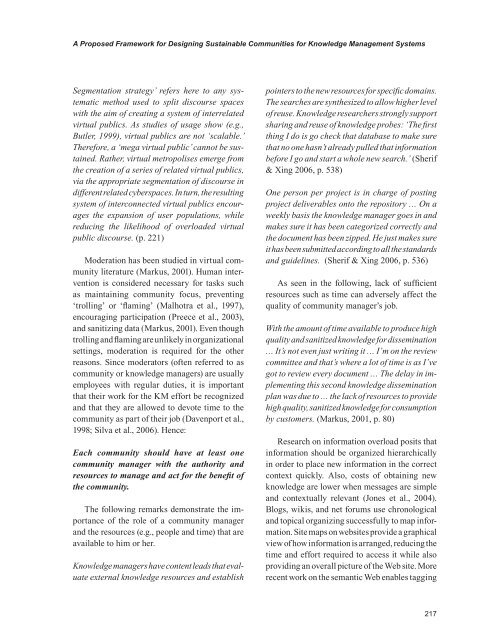Web-based Learning Solutions for Communities of Practice
Web-based Learning Solutions for Communities of Practice
Web-based Learning Solutions for Communities of Practice
You also want an ePaper? Increase the reach of your titles
YUMPU automatically turns print PDFs into web optimized ePapers that Google loves.
A Proposed Framework <strong>for</strong> Designing Sustainable <strong>Communities</strong> <strong>for</strong> Knowledge Management Systems<br />
Segmentation strategy’ refers here to any systematic<br />
method used to split discourse spaces<br />
with the aim <strong>of</strong> creating a system <strong>of</strong> interrelated<br />
virtual publics. As studies <strong>of</strong> usage show (e.g.,<br />
Butler, 1999), virtual publics are not ‘scalable.’<br />
There<strong>for</strong>e, a ‘mega virtual public’ cannot be sustained.<br />
Rather, virtual metropolises emerge from<br />
the creation <strong>of</strong> a series <strong>of</strong> related virtual publics,<br />
via the appropriate segmentation <strong>of</strong> discourse in<br />
different related cyberspaces. In turn, the resulting<br />
system <strong>of</strong> interconnected virtual publics encourages<br />
the expansion <strong>of</strong> user populations, while<br />
reducing the likelihood <strong>of</strong> overloaded virtual<br />
public discourse. (p. 221)<br />
Moderation has been studied in virtual community<br />
literature (Markus, 2001). Human intervention<br />
is considered necessary <strong>for</strong> tasks such<br />
as maintaining community focus, preventing<br />
‘trolling’ or ‘flaming’ (Malhotra et al., 1997),<br />
encouraging participation (Preece et al., 2003),<br />
and sanitizing data (Markus, 2001). Even though<br />
trolling and flaming are unlikely in organizational<br />
settings, moderation is required <strong>for</strong> the other<br />
reasons. Since moderators (<strong>of</strong>ten referred to as<br />
community or knowledge managers) are usually<br />
employees with regular duties, it is important<br />
that their work <strong>for</strong> the KM ef<strong>for</strong>t be recognized<br />
and that they are allowed to devote time to the<br />
community as part <strong>of</strong> their job (Davenport et al.,<br />
1998; Silva et al., 2006). Hence:<br />
Each community should have at least one<br />
community manager with the authority and<br />
resources to manage and act <strong>for</strong> the benefit <strong>of</strong><br />
the community.<br />
The following remarks demonstrate the importance<br />
<strong>of</strong> the role <strong>of</strong> a community manager<br />
and the resources (e.g., people and time) that are<br />
available to him or her.<br />
Knowledge managers have content leads that evaluate<br />
external knowledge resources and establish<br />
pointers to the new resources <strong>for</strong> specific domains.<br />
The searches are synthesized to allow higher level<br />
<strong>of</strong> reuse. Knowledge researchers strongly support<br />
sharing and reuse <strong>of</strong> knowledge probes: ‘The first<br />
thing I do is go check that database to make sure<br />
that no one hasn’t already pulled that in<strong>for</strong>mation<br />
be<strong>for</strong>e I go and start a whole new search.’ (Sherif<br />
& Xing 2006, p. 538)<br />
One person per project is in charge <strong>of</strong> posting<br />
project deliverables onto the repository … On a<br />
weekly basis the knowledge manager goes in and<br />
makes sure it has been categorized correctly and<br />
the document has been zipped. He just makes sure<br />
it has been submitted according to all the standards<br />
and guidelines. (Sherif & Xing 2006, p. 536)<br />
As seen in the following, lack <strong>of</strong> sufficient<br />
resources such as time can adversely affect the<br />
quality <strong>of</strong> community manager’s job.<br />
With the amount <strong>of</strong> time available to produce high<br />
quality and sanitized knowledge <strong>for</strong> dissemination<br />
… It’s not even just writing it … I’m on the review<br />
committee and that’s where a lot <strong>of</strong> time is as I’ve<br />
got to review every document … The delay in implementing<br />
this second knowledge dissemination<br />
plan was due to … the lack <strong>of</strong> resources to provide<br />
high quality, sanitized knowledge <strong>for</strong> consumption<br />
by customers. (Markus, 2001, p. 80)<br />
Research on in<strong>for</strong>mation overload posits that<br />
in<strong>for</strong>mation should be organized hierarchically<br />
in order to place new in<strong>for</strong>mation in the correct<br />
context quickly. Also, costs <strong>of</strong> obtaining new<br />
knowledge are lower when messages are simple<br />
and contextually relevant (Jones et al., 2004).<br />
Blogs, wikis, and net <strong>for</strong>ums use chronological<br />
and topical organizing successfully to map in<strong>for</strong>mation.<br />
Site maps on websites provide a graphical<br />
view <strong>of</strong> how in<strong>for</strong>mation is arranged, reducing the<br />
time and ef<strong>for</strong>t required to access it while also<br />
providing an overall picture <strong>of</strong> the <strong>Web</strong> site. More<br />
recent work on the semantic <strong>Web</strong> enables tagging<br />
217



